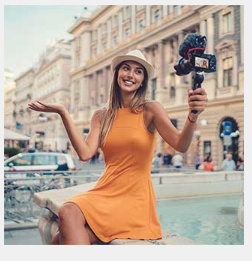 How can we get away from Branded Influencer Fatigue and give a new impetus to influence marketing? The image of this lever has been tarnished by bad practices, leading to consumer—and advertiser—mistrust of influencers on social networks, as we discovered in Kantar’s “Social Media Trends 2019” study.
How can we get away from Branded Influencer Fatigue and give a new impetus to influence marketing? The image of this lever has been tarnished by bad practices, leading to consumer—and advertiser—mistrust of influencers on social networks, as we discovered in Kantar’s “Social Media Trends 2019” study.
From macro to micro: How influence has shifted to smaller, more authentic connections
The rise of ad blocking and a growing distance from brand discourse have led to a major transformation with the advent of social networks: consumers have increasingly turned to their peers to validate their consumer choices. Brands have acknowledged this and have increasingly leveraged these influencers to increase their visibility, increase their sales and install a successful model. After initially focusing on celebrities and then macro influencers, advertisers realized that micro influencers could be a strategic asset.
As a result, UGC (user-generated content) campaigns have multiplied: “social” evidence has become a proof of trust; and the more authentic it is considered to be, the more favorable it is to the brand. For these “next-door bloggers,” the platforms could even be an essential lever to propel them into their communities. Lisa Gachet started as a micro-influencer before creating her own clothing brand, Make My Lemonade (260,000 Instagram followers as of September 2019).
Symptoms of Branded Influencer Fatigue (BIF): Can we recover?
With the boom and bustle of influence marketing in recent years, a number of abuses have taken hold. As a result, consumer trust has been damaged. Consumers are more aware and demanding, and have distanced themselves from content from influencers. And that’s without mentioning the many slippages and the multiplication of paid partnerships that have led to fatigue and even a feeling of saturation. This has been dubbed Branded Influencer Fatigue. By accumulating too many collaborations, some influencers have already lost their subscribers—who can no longer relate to their values—or have seen their engagement rates collapse.
A high-profile New York Times investigation, published in 2018, marked the start of a turning point, pointing to a parallel dark market for fake accounts, influencers and comments. One example is of a teenage girl from Minnesota, Jessica Rychly, who was impersonated by a fake Jessica avatar.
Fake Jessica, a bot, was being used to promote anything from Canadian real estate investments to crypto currency to pornographic sites. Jessica’s Twitter account, along with many others, was sold by American company Devumi to businesses, celebrities, and influencers, in order to artificially inflate their profiles with followers and retweets.
What’s next? Rebuilding trust
Faced with these abuses, we can now observe a real reaction from the market. Already there are best practice charters, better detection of fakes, and close management by brands of the entire range of influencers (including nano-influencers). There is also a general trend towards self-regulation by influencers themselves. In France, for example, this is reflected in the new special prize for influencers and ethics awarded by ARPP, the French professional advertising self-regulatory authority.
The challenge for brands is to regain credibility on this lever of influence marketing by becoming aware of a mistake made on a large scale. They considered influencers to be like a standard marketing channel, whereas so much of the power of influencers is rooted in humanity, relationships and, above all, trust. To forge ahead, it is the responsibility of brands to act transparently, to focus on affinities and values in their relations with influencers, and offer the consumer an ever more qualitative experience.
Written by François Nicolon,CMO, Media Division Kantar


